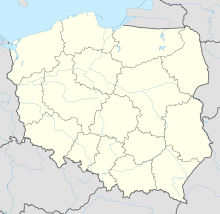Rügenwalde-Bad shooting range
Coordinates: 54 ° 24 ′ 13.3 ″ N , 16 ° 21 ′ 10.1 ″ E
The Rügenwalde-Bad firing range south-west of Rügenwaldermünde ( incorporated into the Rügenwalde-Bad district of the city of Rügenwalde as part of the Rügenwalde-Bad district since 1936 ) in Western Pomerania is a historic firing range for heavy artillery of the Wehrmacht , which played an important role in World War II , as it was where heavy artillery shot at long range including railway guns and the heaviest guns in military history worldwide.
During the First World War , a small military airfield was built near the Darlowberg hill southwest of Rügenwaldermünde . In 1935, in the vicinity, in the Suckowschen Heide and in the neighboring pine forests southwest of Rügenwaldermünde, the construction of a large-scale firing range for heavy artillery began. The shooting range was connected to the public transport network via a new asphalt road and a new rail line. In the fenced area, which a private security company had been charged with guarding, there were numerous cross streets and its own rail network. From Rügenwaldermünde, the entrance gate could be reached from Parkstrasse . To the left of the entrance was the commandant's barracks , to the right opposite that of a branch of the new Army Headquarters. The conglomerate of administration buildings, defense technology institutions, factories, workshops, warehouses and barracks on the shooting range resembled a small town in terms of area.
The defense equipment of the firing range included:
- four gun positions
- a shooting frame for receiving and shooting in delivered gun barrels
- a 14-meter-high lifting crane with a payload of 150 tons, with the help of which the gun barrels could be transported back and forth between the railroad cars and the shooting frame
- a turntable with a diameter of approx. 35 meters and a railroad track sunk into the ground to accommodate heavy railway artillery
- a 50 meter high observation tower
- an ammunition factory with corresponding production halls in which the propellants for the projectiles were filled and the projectiles were assembled
- an artillery workshop
- several warehouses
- a radio, telegraph and telemetry station with an antenna tower
- a ballistic institute for the recording and evaluation of the ballistic measured values obtained during the test series.
Gun barrels with a length of up to 47 meters were shot in at the Rügenwalde-Bad firing range. The bullets routinely tested had a caliber between 15 cm and 28 cm and a weight between 75 kg and 250 kg.
For long range guns, a target area in the Baltic Sea 80 km away in the sea area in front of Großmöllen and Henkenhagen was used. A target area in the Baltic Sea in the sea area off Swinoujscie and Dievenow was available for guns with a range of 120 to 130 km. Before the tests, normal shipping traffic was warned and kept away from the target areas with the help of surveillance vessels.
Among other things, the 33-meter-long K-5 railway gun , whose nominal range was 80 km, was tested . The projectiles had a caliber of 28 cm and weighed 250 kg, of which around 100 kg were propellant. In order to achieve greater ranges, an additional propellant could be added. At the rear of the gun, which was anchored on the turntable, was a power unit that supplied both the gun itself and the turntable with electrical power. Integrated into the gun was a lifting crane located at its rear, with which the projectiles could be transported to the cannon's loading bay.
At the Rügenwalde-Bad firing range, the heavy Gustav Gustav and Karl mortar artillery were shot in .
The firing range was frequently visited by staff officers of the Army , Air Force and Navy , including Grand Admiral Erich Raeder and Marshals Keitel and Rundstedt, as well as Hermann Göring several times . In a secret operation, the firing range was once visited surprisingly by Adolf Hitler accompanied by Benito Mussolini .
Towards the end of the war, the most important defense systems and equipment at the firing range were blown up by the Wehrmacht. After the end of the war, the shooting range was used by the Soviet army . Later he was handed over to the Polish army . More recently (2008) international conferences on defense technology and international security have been held there at regular intervals. The neighboring military airfield on Darlowberg is still in operation.
Footnotes
- ↑ Carlheinz Rosenow: Rügenwalde an der Ostsee - Small history of the hometown , in: Der Kreis Schlawe - A Pomeranian Homeland Book (M. Vollack, ed.), Volume II: The cities and rural communities , Husum 1989, ISBN 3-88042-337- 7 , p. 691.
- ↑ Erich Ziervogel: Der Schießplatz Rügenwalde-Bad , in: Der Kreis Schlawe - Ein Pommersches Heimatbuch (M. Vollack, ed.), Volume I: The circle as a whole , Husum 1986, ISBN 3-88042-239-7 , p. 294-296.
- ↑ map PL008: Pomerania , 9th edition, Höfer-Verlag, Dietzenbach 2005, ISBN 978-3-931103-14-9 .
